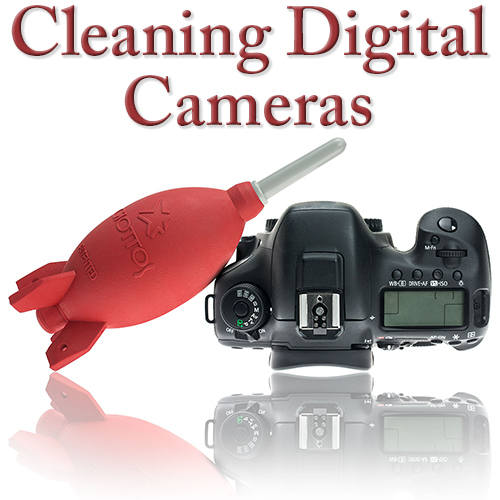FAQ
(Q) How often should I clean my sensor?
(A) I personally inspect my
sensor before every important shoot. When I'm out on location doing a shoot, I inspect my sensor every night and if I find any dust, I clean it. It takes longer to download 32GB of images to
Lightroom than it does for me to clean my sensor.
(Q) Do I need to use two different sized swabs if I have a camera with a 1.6x sensor and one
with a full frame sensor?
(A) It is best to use the
appropriate sized swab for each sensor. You can’t use a large swab on a small sensor because it won’t fit.
If you use a small swab on a large sensor, it isn’t going to cover the entire width of the sensor, making it a much tougher job to clean.
(Q) Where did you get the information used to develop this site?
(A) Over 150 sources were researched and it still isn't complete.
- Visited over 100 web sites
- Visited 15+ different online sensor cleaning tutorials
- Visited over 20 Forums
- Spoke with all 7 DSLR Manufacturer's repair departments
- Spoke with many professional Camera Repairmen who clean multiple brands of cameras on a daily basis
- Our firsthand knowledge on the subject
(Q) How long has Fargo Enterprises, Inc., been in the business of educating the consumer?
(A) This is our first educational site of this type, although we have been doing other types of free education since the
early 90's. Fargo Enterprises, Inc., sponsored FREE four-day Camera Repair Seminars annually starting in 1998 and continued them through 2001. We have had a FREE online Parts and Service Directory
since the mid 90's and we have provided a source free of charge for the camera repair industry to communicate called CamTechNet since the early 90's. For many
years we have also offered parts manuals for Kodak Projectors and some cameras free of charge.
(Q) Who was the first to start educating the photographer in cleaning their own cameras?
(A) Technically it was Photographic Solutions but you had to buy their
Sensor Swab® to get the instructions or know someone who had a copy. Photographic Solutions in conjunction with Kodak, developed this process for the Kodak DCS line of cameras. As for the first to
post free online, it was FUJI in June of 2000 with the release of their S1 Pro. Micro-Tools started
selling these products in early 2001. Fuji has since moved away from Photographic Solutions' products.
(Q) Who was the first to use a device wrapped with a tissue to clean a DSLR sensors?
(A) Kodak did so before the Sensor Swab® was developed. Canon and Nikon followed up with this same process once they
introduced their own DSLRs and do to this day.
(Q) Why don't all camera manufacturers support/recommend the consumer cleaning their own sensor?
(A) It all comes down to liability and sometimes if it wasn't a procedure developed by their corporate R & D it can't be
used.
(Q) Why are the manufacturers sending cameras back that aren't perfectly clean when they were sent in for a cleaning?
(A) I'm not here to make excuses for the manufacturers but once your camera has been used, it has dust on it and in it. It is not economical or necessary to fully disassemble your camera and remove every stray piece of dust. Then, once the camera's sensor is cleaned, the camera has to be shipped back to you. If you have ever seen UPS or the USPS at work, you know how packages get treated like footballs. This shipping dislodges dust particles that end up floating around and then fall onto the sensor. This is why I recommend you do the cleaning yourself or walk the camera into a "Camera Repair" facility that does it in-house. If they missed a spot that was there before, shame on them, because they more than likely were not using the Methanol and Swab method of cleaning.
(Q) Can I use "Methanol - CAS # 67-56-1" instead of Eclipse®, ULTRAPure or Gamma sensor cleaning fluid?
(A) Absolutely. All three of these are methanol solutions.
(Q) Why do I see dust spots on some pictures but not on others that were taken minutes before or after?
(A) Dust may not be visible when shooting until shooting at f/22 or higher. It is directly related to the volume of light
trying to go through and/or around that spot of dust on the filter in front of the sensor. The greater the volume of light (larger aperture opening) the more chance for the light to go through and/or
bleed around the speck, diminishing the shadow on the sensor. On the other hand, using a smaller aperture lets a smaller volume of light in but for a longer period of time, causing more of a shadow.
You can use this knowledge to your advantage by opening up your lens (using a larger aperture opening such as f/5.6) if you get caught out in the field without the tools to clean and you have dust on
your sensor.
(Q) What is the difference between CCD and CMOS?
(A) Canon explains this very well at Canon
Technology


